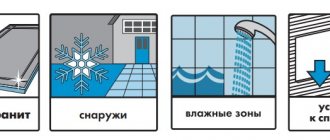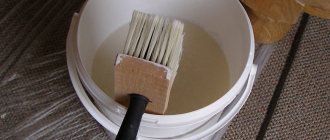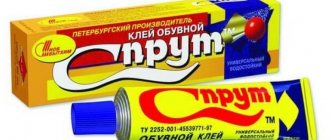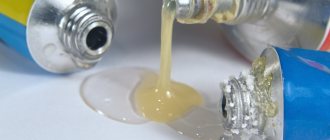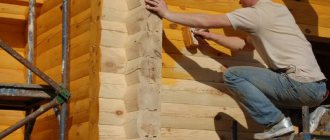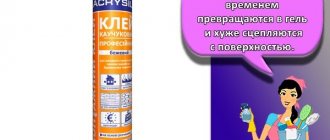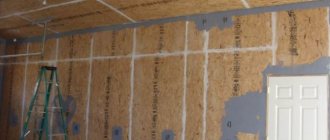| Place | Name | Characteristics in the rating |
| The best PVA glue |
| 1 | Kleiberit 303.0 | The most waterproof PVA glue |
| 2 | Krass PVA PVA D3 | The most transparent wood glue |
| 3 | Moment Joiner PVA Universal | The best domestic glue |
| The best polyurethane adhesives |
| 1 | Kleiberit 501.0 | The best all-purpose glue |
| 2 | SOUDAL 66A | Highest adhesion |
| 3 | Akfix PA370 D4 | Fast drying and excellent heat resistance |
| The best resin-based adhesives for wood |
| 1 | Titebond Original Wood Glue | The best professional glue |
| 2 | Uhu plus endfest 300 | The strongest glue |
| 3 | EDP epoxy glue | Best price |
| Modern synthetic based adhesives |
| 1 | Titebond III Ultimate Wood Glue 1415 | The most harmless glue |
| 2 | Quilosa Bunitex P-55 | Does not lose its properties over time |
| 3 | Forbo 650 Eurostar Fastcol | High fixation |
What types are there?
Wood adhesive compositions based on polyurethane, organic resins and PVA have gained great popularity and love among consumers.
Kinds
Products for gluing wood have different compositions and areas of application. Most materials are positioned as universal products, for which fastening wooden elements is only one of the areas of use. Other products are produced as single-purpose formulations, so they are not intended for contact with other types of materials.
There are several different compositions.
- PVA glue is sometimes called a dispersed adhesive.
The main characteristics of such products are:
- lack of toxicity, due to which the composition can be used indoors without additional safety measures;
- quick adhesion to the surface;
- static load of 60 kg/cm2;
- unlimited service life of the product;
- Can be used on any surface.
The disadvantage of this glue is the method of diluting it, which is based on adding water, which negatively affects the reliability of fixation in rooms with high humidity levels. To ensure high-quality gluing of elements, it is recommended to add wood dust to this glue.
- Epoxy adhesive is a two-component composition, the use of which requires mixing substances in a given ratio. The product provides strong fixation and is universal in terms of application. Epoxy compounds are waterproof, resistant to aggressive substances and fuels and lubricants. The time for complete hardening depends on the thickness of the applied layer. The disadvantages of the material include the need to protect the skin and overconsumption, since it is impossible to calculate exactly how much ready-made solution will be needed to treat the surface.
- BF is a type of glue that includes several variants of the product. For wood materials, series 2 and 4 are recommended. This composition has the feature of very fast hardening. On average, this requires 50-60 minutes, but provided that the humidity and temperature are within normal limits.
The compositions must be applied in two layers with short intervals. The fourth series of glue is frost-resistant products. The disadvantage of BF is the need for mandatory preliminary cleaning of the wooden surface with degreasing.
- Heat-resistant adhesive compositions produced in the form of rods. To work with such products you will need a special gun. The scope of application of the products mainly concerns fastening small parts or sealing defects in a wooden surface.
- Wood adhesives. To work, the products need to be prepared. Wood glue is based on organic protein, which is the main adhesive substance. It is necessary for joining various wood materials: hardboard, paper, cardboard, wooden products. The natural composition ensures safety of use.
The origin of the main component of carpentry compositions is different.
Products are classified based on the type of raw materials.
- Mezdrovy. The main component in such products is a substance that is formed during the processing of animal skin. The material can be produced in the form of flakes, tiles or powder.
- Bone. The raw materials for it are the bone remains of animals. The products have an average price. It is better to use a transparent composition instead of unrefined mixtures with impurities.
- Casein. Widely used in aircraft modeling and shipbuilding. It is neutral to dampness and forms a strong connection. To prepare the composition, you must strictly observe the proportions and time interval.
- Fishy. It is prepared from the remains of fins and scales. The composition is considered a professional product intended for gluing surfaces with varying degrees of hardness. The glue has a fairly high cost, so it is positioned as a furniture glue and is used for the repair or restoration of expensive furniture.
- Moisture-resistant solution. You can prepare it yourself using slaked lime and cottage cheese, which has recently curdled.
There is a certain technology for making wood glue. To do this, the dry mass is poured with water and left for 6-12 hours so that the composition completely absorbs moisture. Then the remaining water is drained, and the mixture is heated in a water bath until the substance is completely dissolved. The cooking process requires periodic stirring. It is important to control the process so that the mixture does not boil. The glue is applied strictly in the direction of the wood fibers, then the elements are pressed against each other and fixed. The main disadvantage of the product is the reduction in gluing efficiency in the case of wood moisture content exceeding 10%.
See also: 18 best air purifiers and air washers
- Syndeticone glue. It is prepared from wood glue with the addition of lime and powdered sugar. The product is distinguished by a high level of strength of the connection of elements. The glue is waterproof and resistant to chemicals. The disadvantage of the product is the rather long preparation process, since the mixture for the solution must be kept in water for 24 hours.
- Glue paste. It is prepared on the basis of carpentry composition, wood ash and chalk. The material performs well when priming and puttying wood.
- Polyurethane products. It is the most expensive among the above range. The material has a number of positive features. The area where the composition is applied perfectly withstands high dynamic loads.
This material is ideal for repairing furniture, such as chair legs that become loose over time. The composition is also highly resistant to various temperatures, moisture and solar radiation. It is better to glue wooden structures that are used in extreme conditions with this particular composition.
The best resin wood glues
The composition of various resins has many useful qualities. It will not change the shade of the wood being processed, has excellent adhesion, high strength and electrical insulating qualities. However, when working with adhesive composition, proper room ventilation and the use of personal protective equipment are necessary. When comparing 7 products, it was determined which one is better. The list contains 3 of them.
Moment Joiner
Composition based on epoxy resin, an excellent product from domestic manufacturers. Using the composition, it is possible to combine various types of wood, plywood, MDF, fiberboard, chipboard, plastic with paper inclusions. The surfaces to be glued need to be pressed for a quarter of an hour using a clamp or vice. The complete drying time for the elements before use will be 1 day. The product does not change the shade of the processed material, which will increase the scope of its use. The product can be used at positive temperatures from +5 to +30 degrees.
Experts and amateur craftsmen note the following characteristics of Moment Joiner: short drying period, reliability, accessibility, transparency after hardening. The disadvantages include sensitivity to moisture and low temperatures.
Advantages
- Transparency after drying;
- Convenient use;
- Quick drying;
- High initial grip.
Flaws
- Poor resistance to moisture.
It is made on the basis of epoxy resin, therefore it is not toxic to the user. It is economical in use and is effective for all types of wood.
Titebond joinery moisture resistant
1-component adhesive for gluing wood materials. It has a high class of water resistance and can be effectively used for outdoor work: assembling garden furniture, birdhouses, mailboxes. The composition is characterized by a strong initial setting, rapid hardening, creates a reliable seam, and is easy to process. The downside will be susceptibility to moisture and negative temperature parameters.
Advantages
- Connection reliability;
- Versatility of use;
- Fast setting;
- Holding period in clamps;
- Cutting tools do not deteriorate when processing the joint.
Flaws
- Weak water resistance;
- Big expense.
Users note strong adhesion of the adhesive composition in a short period. The disadvantage is that the funds are spent quickly.
Uhu Plus Endfest 300
Two-component universal wood adhesive has good gluing properties. It is made of epoxy resin, which will allow materials of different origins to be glued to the wooden object being processed. The exception will be glass items. The composition hardens within 1.5 hours, the joints are fully ready for use within 12-24 hours. The seam will become impact-resistant, wear-resistant and moisture-resistant.
To make a working solution, you need to mix 2 ingredients, following the developer's instructions. Then the components are thoroughly mixed until a homogeneous consistency is formed. The finished composition is applied with a brush or spatula. Among the advantages of glue from a German brand, the emphasis is on high strength, resistance to mechanical influences, and moisture. It is characterized by reliable initial setting and high adhesion.
Advantages
- Reliability;
- Immunity to moisture;
- Durable grip;
- Connection of any objects with wood;
- Does not conduct current.
Flaws
- Proportions must be observed;
- You need to prepare a working solution.
Based on reviews, the adhesive composition has increased strength, immunity to mechanical influences and moisture.
The safety of the mixture, which is used both for home and industrial purposes, is noted.
Recommend a colorless furniture glue!
To glue wood you need wood glue, not universal! Wood glue 1. Aliphatic vinyl acetate emulsions (any PVA) with cross-links. Any PVA-based glue cannot be frozen. PVA – You can wrap the gluing process with acetone. Use a syringe to inject the solution into the gluing area. a) moisture-resistant b) Not moisture-resistant, Titebond craquelure adhesive is spatially suspended polyacrylates. www.titebond.com www.titebond.ru Titebond Original Wood Glue Titebond II Premium Wood Glue titebond 3 Ultimate III Wood Glue with green label MOMENT Joiner Super PVA D3 www.moment.ru Moment, Rakoll are polyvinyl acetate-based adhesives with various additives. Rakoll GXL-4. Single-component adhesive water resistance D4. This glue is slightly acidic (pH about 3.5), so it is not recommended to use equipment made of non-ferrous alloys and aluminum. Suitable for stainless steel, polyethylene, polystyrene, etc. Jowat and Rakoll come with a hardener (sold in a separate bottle and mixed with the bulk before use), and the bonded surfaces do not come apart even in water. hardener PEPA, TETA + plasticizer. Casco Renakoll
Pros: Good adhesion. High strength of the adhesive joint (especially against shock and periodic loads). Penetrates well into the wood structure. Transparency (some brands). Easy to use even in a home workshop. Availability and low cost. Maintainability of gluing - gluing with a hot knife, in principle, can be disassembled without much loss, as a rule. Cons: weak resistance to “creep” under load. If loaded parts are filled with a thin layer of nitro varnish or covered with a French finish, over time the adhesive seam will reveal itself as a crack in the finish coating. sometimes strange behavior when overheating. Moreover, there are cases of individual parts peeling off when exposed to direct sunlight, which is unthinkable for epoxy and mezdra. fairly low dry residue. This is a minus only for Alena, who are not able to properly fit the parts for gluing. In other cases, it’s more likely even a plus. I use it mainly in cases where there is no time to tinker with my favorite core or epoxy. Only for gluing lightly loaded parts. Sometimes I use it as a filler for a French finish, mixing the emulsion with wood powder of the appropriate color.
2. Epoxy may leak during the drying process. Poor adhesion to smooth surfaces. not for wood, fragile seam. An option for loose connections, and for normal ones too. It holds up excellently, but it takes a long time to harden. mix with sawdust. The flow depends on the thickness of the spread, and the speed of hardening depends on the amount of hardener. Pros: Excellent adhesion. High durability and strength of the adhesive seam. Highest creep resistance under load. Transparency (no color with TETA hardener, yellowish-transparent with PEPA). Good penetration into the wood structure. High solids. Cons: Uneven quality in the sense of an unclear degree of modification with plasticizers. A partial solution is to buy pure epoxy, say at epoksid.ru, and glaze it yourself. But, if done correctly, it requires several hours of cooking with dibutyl phthalate - a bad option for a home workshop. Requirements for elevated curing temperatures. A drop of epoxy that goes unnoticed in time cannot be removed by anything. Only cut with a small layer of wood. Low repairability of gluing. It is almost impossible to disassemble what has been glued together. I mix with 5-10 cc syringes, preheating the resin in a water bath to reduce the viscosity. Up to 50 degrees, no more, otherwise the resin may either boil or form a stake while still in the syringe, before being applied to the material. I use it most of all for impregnating wood surfaces as an alternative to a tung finish. Compared to the latter, epoxy gives a harder and more “glassy” surface. Well, this is also my main glue for gluing in abalone inlay. With filler if it is ebony, or without it if it is maple.
3.Mezdra Pros: High adhesion. Very good penetration into the wood structure, even on closed-pore woods (some problems only occur on very heterogeneous woods such as wenge). Transparency in the case of high-quality peeled flesh (with a slight amber tint). If the flesh is from the nearest construction market, then it is most likely gray. Highest creep resistance. High adhesive strength. Of the gluten glues, it is second only to sturgeon, but it costs like a Cadillac. Highest repairability of gluing. Like all gluten glues, the mesh is reversible and therefore any seam can be taken apart with a hot knife and some water without damaging the entire product. Quite easy to work with, even in the form of granules, but with some skill. All blots can be easily washed off with a rag without delay. Cons: Low resistance to moisture. The adhesive joint must be reliably protected by a paint coating. Not suitable for outdoor work at all. Humidity plus severe overheating (for example, due to careless use of a sander) can lead to unraveling of the seam. Slightly reduced strength to impact loads compared to polymers (viscosity is not very high). Relatively low availability for quality purified varieties. Behlen Dry Ground Hide Glue is poured with water, then steamed in a water bath. The resulting jellied meat can be stored in the refrigerator for a long time. Then I just steamed it lightly and went to work. It is better to warm up the surfaces for gluing; I do this with an iron in steam mode. You don’t have to do it, but in this case the flesh folds up very quickly and you have to be very careful with it. Mezdra is very well suited for veneering, because it softens to a liquid state when exposed to steam and then quickly grabs the veneer. True, my surfaces for veneering are not very large. There is liquid glue from Titebond, which is purely carpentry glue. Allows you to obtain absolutely invisible seams, detectable only by the different paths of the fibers, and not by the presence of a layer of glue between the workpieces being glued. In most cases, it is not suitable for carpentry work.
4. PUR Kleiberit plus swelling with filling of all joints. For chairs - PVA if the tenon groove connects tightly. pur is not durable. PUR is less durable than PVA. when gluing boards for the production of chair parts, D3 is required. too elastic and suitable for walking products (boards). when assembling a chair into a tongue-and-groove system, only d4. strong and hard enough to hold a spike.
Classification of adhesives according to DIN EN 204 standards -D1, D2, D3, D4 D1 Indoors at an ambient temperature of no more than 50 ° C and wood humidity up to 15%. A short-term increase in air temperature and wood humidity is allowed. D2 Indoors. Short-term exposure to running water or condensate is allowed, leading to an increase in wood moisture content up to 18%. water resistance is extremely weak. D3 Indoors with periodic short-term exposure to running water or condensation and/or a short-term increase in air humidity. Outdoors, with adequate protection from prolonged exposure to adverse weather conditions. water resistance is good, the compounds can withstand changes in humidity and short-term wetness. D4 Indoors with strong running water or condensation and prolonged exposure to high air humidity. Outside the premises, the adhesive joint is resistant to adverse weather conditions, however, if possible, a protective coating should be applied to the product. high water resistance. Suitable for outdoor furniture. a) D4 is usually two-component - prepared immediately before use. b) One-component - sold in finished form (additives are added to the composition at the factory). However, the shelf life of such adhesives is usually very short - no more than six months. D5 2-component synthetic adhesives for industrial use. the plasticizer additive raises the level of water resistance of the adhesive D2 to the level of D3-D4. If there is no need, there is no need to strive for the water resistance of the glue. As a rule, it glues weaker than classic wood glue.
matting - if the surface is glossy, then it should be rubbed with sandpaper to make it slightly rough. If the gluing is critical, stick strips of masking tape on the adjacent edges and cut them along the edge. After fixing the connection, when all the excess glue is squeezed out, remove the tape without waiting for the glue to harden. Gauze or cotton rag from old sheets, pillowcases, impregnated with PVA - this is a very high-quality reinforced material.
Liquid nails - construction adhesive. Unlike conventional glue, liquid nails contain fine-grained filler, which makes it possible to glue loosely fitting parts and can withstand heavy loads. The basis of Liquid nails is synthetic rubber with the presence of polymers. 2 types of liquid nails: a) neoprene - based on an organic solvent. They are not harmless and have a pungent odor that lasts for several days after installation. b) water-based acrylic - based on water. They are harmless and environmentally friendly, but are only suitable for porous materials (tiles) and are susceptible to high humidity.
Features of adhesive compositions
Regardless of the type of glue, all wood mixtures have a number of characteristic features. First of all, they are characterized by increased strength. Even if the wood begins to deteriorate, the adhesive coating will retain its integrity. Most materials can only be used in a heated state (in particular, this applies to natural adhesives of organic origin). Heating is carried out in a water bath, since when using direct fire there is a high probability of loss of adhesive properties.
